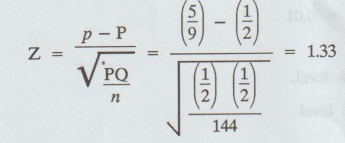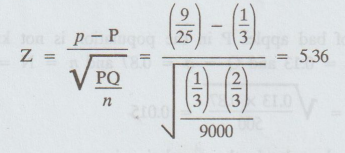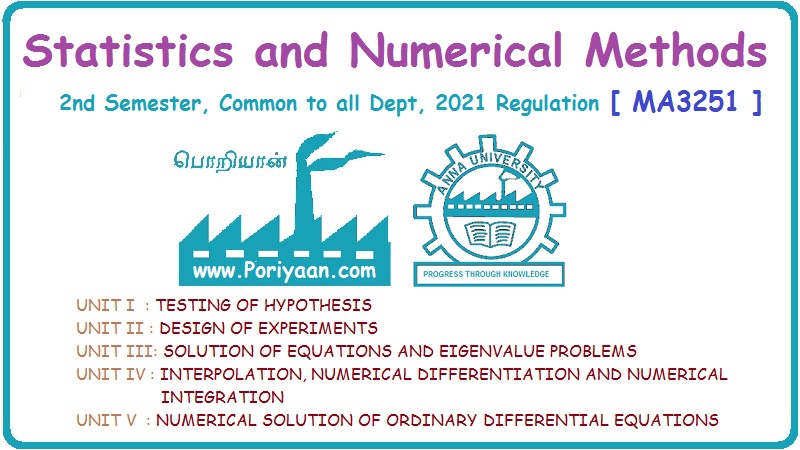Statistics and Numerical Methods: Unit I: Testing of Hypothesis
Large sample test for Single proportion
Solved Example Problems | Testing of Hypothesis | Statistics
If X is the number of successes in n independent trials with constant probability P of success for each trial.
Large sample test for Single proportion
I. Test for a Single proportion
If
X is the number of successes in n independent trials with constant probability
P of success for each trial.
E(X)
= nP and V(X) = nPQ
where
Q = 1 P, is the probability of failure.
It
has been proved that for large n, the binomial distribution tends to normal
distribution. Hence for large

and
we can apply the normal test.

Example
1.2.c(1)
In
a sample of 1,000 people in Maharashtra, 540 are rice eaters and the rest are
wheat eatrs. Can we assume that both rice and wheat are equally popular in this
state at 1% level of significance.
Solution:
Given:
n = 1,000, X = 540, p = X / n = 540 / 1000 = 0.5
P
= Population proportion of rice eaters in Maharastra = 1/2 = 0.5
Q
= 1 - P = 1- 1/ 2 = 1/2 = 0.5
1.
H0 P = 0.5 [Both rice and wheat eaters are equally popular in the
state]
2.
H1: P ≠ 0.5
3.
ɑ = 0.01
4.
Table value |Z| = 2.58
5.
Calculate :

6.
Conclusion :
Here,
Cal Z < table Z
i.e.,
2.53 < 2.58
So,
we accept H0 at 1% level of significance.
We
may conclude that rice and wheat eaters are equally popular in Maharashtra
state.
Example
1.2.c(2)
Twenty
people were attacked by a disease and only 18 survived. Will you reject the
hypothesis that the survival rate, if attacked by this disease, is 85% in
favour of the hypothesis that it is more, at 5% level. (use large sample test)
[A.U. N/D 2013]
Solution:
Given:
n = 20
Mal
slqooq 000, I to
X
= number of persons who survived after attack by a disease = 18
p
= X / 20 = 0.90
P
= 0.85
Q
= 1 - 0.85 = 0.15
1.
H0 : P = 0.85 [no significant difference]
2.
H1 : P > 0.85 [One tail test]
3.
ɑ = 0.05
4.
Table value |z| = 0.626
5.
Calculate :

6.
Conclusion :
Here,
Cal Z < table Z
i.e.,
0.626 < 1.645
So,
we accept Ho at 5% level of significance.
Example
1.2.c(3)
A
manufacturer claimed that at least 95% of the equipment which he supplied to a
factory conformed to specifications. An examination of a sample of 200 pieces
of equipments revealed that 18 were faulty. Test his claim at a significance
level of (i) 5% (ii) 1%.
Solution:
Given
n = 200
X
= Number of pieces conforming to specifications in the samples
= 200 - 18 = 182
p
= Sample proportion conforming to specifications
P
= 0.95, Q = 1 P = 1 0.95 = 0.05
1.
H0 : P = 0.95 [The proportion of pieces conforming to specification
in the population is 95%]
2.
H1 P < 0.95 [at least 95% conformed to the specification]
3.
(i) ɑ = 0.05, (ii) ɑ = 0.01
4.
Table value
(i)
|Z| > 1.645 at 5% level.
(ii)
|Z| > 2.33 at 1% level.
5.
Calculate :

6.
Conclusion:
(i)
Here, Cal Z > table Z
i.e.,
2.6 > 1.645
So,
we reject Ho at 5% level of significance.
(ii)
Here, Cal Z > table Z
i.e.,
2.6 > 2.33
So,
we reject Ho at 1% level of significance.
Example
1.2.c(4)
A
coin is tossed 144 times and a person gets 80 heads. Can we say that the coin
is unbiased one ?
Solution:
Given
n =144
P
= probability of getting a head in a toss = 1 / 2
Q
= 1 - P = 1 – 1 / 2 = 1 / 2
X
= number of successes
=
number of getting heads = 80.
P
= X / n = 80 / 144 = 5 / 9
1.
H0 = [the coin is unbiased]
2.
H1 : the coin is biased
3.
ɑ = 0.05
4.
Table value |Z | = 1.96
5.
Calculate :

6.
Conclusion :
Here,
Cal Z < table Z
i.e.,
1.33 < 1.96
So,
we accept H0 at 5% level of significance.
Hence
the coin is unbiased.
Example
1.2.c(5)
In
a big city 325 men out of 600 men were found to be smokers. Does this
information support the conclusion that the majority of men in this city are smokers.
Solution:
Given:
n = 600, P = 325 / 600 = 0.5417
P
= Population proportion of smokers in the city = 0.5
Q
= 1- P = 10.5 = 0.50
1.
H0 : p = 0.5
2.
H0 : p > 0.5
3.
ɑ = 1% and 5%
4.
Tabulate | Z |= 2.33, 1% level
|
Z |= 1.645, 5% level
5.
Calculate

6.
Conclusion :
(i)
Here, Cal Z < table Z
i.e.,
2.04 < 2.33
So,
we accept Ho at 1% level of significance.
(ii)
Here, Cal Z > table Z
i.e.,
2.04 > 1.645
So,
we reject H0 at 5% level of significance.
Note:
We cannot come to solid conclusion from this random sample data. We may try for
some other sample data for deciding whether majority of men in that city are
smokers.
Example
1.2.c(6)
A
dice is thrown 9,000 times and a throw of 3 or 4 is observed 3,240 times. Show
that the dice cannot be regarded as an unbiased one and find the limits between
which the probability of a throw of 3 or 4 lies.
Solution:
Given:
n = 9,000
X
= Number of successes
=
Probability of success
=
Probability of getting a 3 or 4 = 1/ 6 + 1/6 = 1/3
Q
= 1 – 1/3 = 2/3
P
= X / n = 3240 / 9000 = 9/25
1.
H0 : P = 1/3 [unbiased]
2.
H1: P ≠ 1/3
3.
ɑ not given.
4.
Table value |Z | = 3 for both the level of significance.
5.
Calculate :

6.
Conclusion :
Since
|Z| = 5.36 > 3 so we reject H0.
We
conclude that the dice is almost certainly biased.
Since
dice is not unbiased, P ≠ 1/3
The
probable limits for 'P' are given by

Hence
the probable limits for the population proportion of successes may be taken by

Hence
the probability of getting 3 or 4 almost certainly lies between 0.345 and
0.375.
Example
1.2.c(7)
A
random sample of 500 apples was taken from a large consignment of apples and 65
were found to be bad. Find the S.E of the population of bad ones in a sample of
this size. Hence deduce that the percentage of bad apples in the consignment
almost certainly lies between 8.5 and 17.5.
Solution:
Given
n = 500.
Let
X = number of bad apples in the sample 65.
p
= proportion of bad apples in the sample = 65 / 500 = 0.13.
Hence
q = 0.87
Here
the proportion of bad apples P in the population is not known.
Hence
we can take P = p 0.13 and Q = q = 0.87 and n = N = 500.
S.E
of proportion √PQ / N = √0.13 × 0.87/
5000 = 0.015
Limits
for proportions of bad apples in the population is

EXERCISE 1.2(c)_______
1.
A person threw 10 dice 500 times and obtained 2560 times 4, 5 or 6. smo Can
this be attributed to fluctuations in sampling ?
Ans.
z 1.697
2.
The difference could be attributed to fluctuations in sampling. While throwing
5 dice 30 times a person obtained success 23 times (securing a 6 was considered
a success). Can we consider the difference between the observed and the
expected results as being significantly different ?
Ans.
z 0.438
The
difference between the sample proportion and the population proportion is not
significant.
3.
In a sample of 500 people in Kerala 280 are tea drinkers and the rest are coffee
drinkers. Can we assume that both coffee and tea are equally popular in the
state at 5% level of significance ?
Ans.
z = 2.68
Therefore
coffee and tea are not equally popular in that state.
4.
In a sample of 600 parts manufactured by a factory, the number of defective
parts was found to be 45. The company however claimed that only 5% of their
product is defective. Is the claim tenable?
Ans.
z = 2.8
5.
Sky packets managing director says with 95% confidence that there has been a
significant improvement in deliveries based on a sample of 81 deliveries out of
which 6 were late. If in general 10% of deliveries were late in the past,
should Managing Director's statement be accepted?
Ans.
z = 0.78
6.
In a certain city 380 men out of 800 are found to be smokers. Discuss whether
this information supports the view that majority of men in this city are
non-smokers.
Ans.
z = 1.414
We
cannot conclude that majority are non-smokers.
7.
A coin is tossed 400 times and it turns up head 216 times. Discuss whether the
coin is an unbiased one. [A.U N/D 2011]
Ans.
The coin is unbiased
8.
A person throws 10 dice 500 times and obtain 2560 times 4, 5 or 6. Can this be
attributed to fluctuations in sampling. Explain.
9.
In a hospital 475 female and 525 male babies were born in a week. Do these
figures confirm the hypothesis that males and females are equal in numbers ?8
bas
Ans.
We may accept the null hypothesis.
10.
Balls are drawn from a bag containing same number of black and white balls,
each ball being returned before drawing another. In 2250 drawings, 1018 black
and 1232 white balls have been drawn. Do you suspect some rea bias on the part
of the drawer.
Ans.
accept the null hypothesis
Statistics and Numerical Methods: Unit I: Testing of Hypothesis : Tag: : Solved Example Problems | Testing of Hypothesis | Statistics - Large sample test for Single proportion
Related Topics
Related Subjects
Statistics and Numerical Methods
MA3251 2nd Semester 2021 Regulation M2 Engineering Mathematics 2 | 2nd Semester Common to all Dept 2021 Regulation
